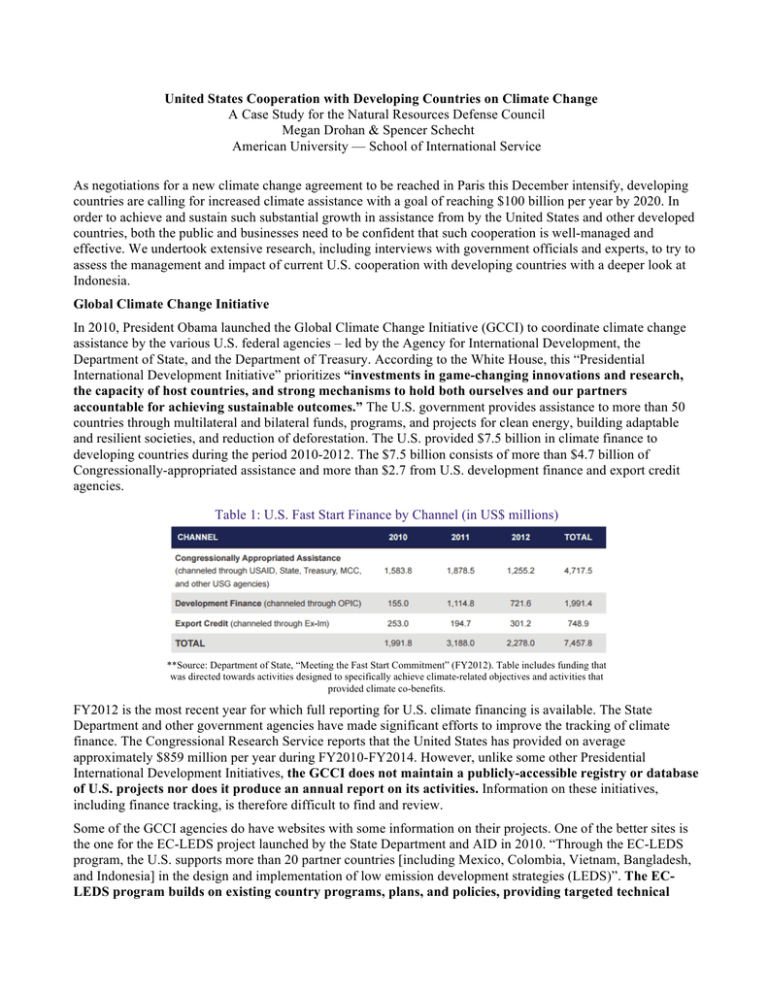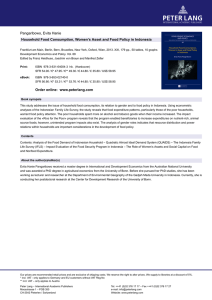A Case Study for the Natural Resources Defense Council
advertisement

United States Cooperation with Developing Countries on Climate Change A Case Study for the Natural Resources Defense Council Megan Drohan & Spencer Schecht American University — School of International Service As negotiations for a new climate change agreement to be reached in Paris this December intensify, developing countries are calling for increased climate assistance with a goal of reaching $100 billion per year by 2020. In order to achieve and sustain such substantial growth in assistance from by the United States and other developed countries, both the public and businesses need to be confident that such cooperation is well-managed and effective. We undertook extensive research, including interviews with government officials and experts, to try to assess the management and impact of current U.S. cooperation with developing countries with a deeper look at Indonesia. Global Climate Change Initiative In 2010, President Obama launched the Global Climate Change Initiative (GCCI) to coordinate climate change assistance by the various U.S. federal agencies – led by the Agency for International Development, the Department of State, and the Department of Treasury. According to the White House, this “Presidential International Development Initiative” prioritizes “investments in game-changing innovations and research, the capacity of host countries, and strong mechanisms to hold both ourselves and our partners accountable for achieving sustainable outcomes.” The U.S. government provides assistance to more than 50 countries through multilateral and bilateral funds, programs, and projects for clean energy, building adaptable and resilient societies, and reduction of deforestation. The U.S. provided $7.5 billion in climate finance to developing countries during the period 2010-2012. The $7.5 billion consists of more than $4.7 billion of Congressionally-appropriated assistance and more than $2.7 from U.S. development finance and export credit agencies. Table 1: U.S. Fast Start Finance by Channel (in US$ millions) **Source: Department of State, “Meeting the Fast Start Commitment” (FY2012). Table includes funding that was directed towards activities designed to specifically achieve climate-related objectives and activities that provided climate co-benefits. FY2012 is the most recent year for which full reporting for U.S. climate financing is available. The State Department and other government agencies have made significant efforts to improve the tracking of climate finance. The Congressional Research Service reports that the United States has provided on average approximately $859 million per year during FY2010-FY2014. However, unlike some other Presidential International Development Initiatives, the GCCI does not maintain a publicly-accessible registry or database of U.S. projects nor does it produce an annual report on its activities. Information on these initiatives, including finance tracking, is therefore difficult to find and review. Some of the GCCI agencies do have websites with some information on their projects. One of the better sites is the one for the EC-LEDS project launched by the State Department and AID in 2010. “Through the EC-LEDS program, the U.S. supports more than 20 partner countries [including Mexico, Colombia, Vietnam, Bangladesh, and Indonesia] in the design and implementation of low emission development strategies (LEDS)”. The ECLEDS program builds on existing country programs, plans, and policies, providing targeted technical assistance that supports the unique national development goals of each partner. Websites and fact sheets refer EC-LEDS as the U.S. Government’s “flagship” for its cooperation with developing countries. Yet there was very little information available on the progress on the program, no documentation, or evaluation reports. U.S.-Indonesia Cooperation on Climate Change Indonesia is the sixth largest emitter of greenhouse gases with deforestation a major source, according to WRI. In 2010, President Obama and former Indonesian President Susilo Bambang Yudhoyono agreed that climate change requires a multifaceted approach and engagement on a variety of levels. The US then supported the establishment of the Indonesia Climate Change Center (ICCC), a national hub for climate policy research and knowledge sharing, and launched the International Forestry and Climate Support (IFACS) program. Indonesia entered into a $600 million compact with the Millennium Challenge Corporation, half of which is designated to Green Prosperity Project initiatives aimed at reducing reliance on fossil fuels and shifting livelihoods away from deforestation. Under the Tropical Forest Conservation Act of 1998, nearly $60 million dollars in “debt for nature” swaps have redirected Indonesian debt into forest conservation. The US Government officials we interviewed considered these programs to be substantial successes, but we were unable to obtain any detailed reviews or evaluations of them. The U.S. Ambassador to Indonesia, Robert O. Blake explained to us that he and his team brainstormed in late 2013 on new ways to address climate change beyond the projects noted above. They decided to focus on the palm oil industry, which is one of Indonesia’s largest emitters due to deforestation associated with the expansion of their plantations. The Ambassador met with CEOs from the palm oil industry and persuaded companies representing 80% of global palm oil production to commit to immediately cease deforestation on high carbon stocks and all peatland. This is an example of the key role that top US diplomatic personnel in country can make in putting climate change higher on the agenda in key countries and making progress in driving policy changes. Findings and Recommendations We found that the U.S. climate cooperation could be strengthened through increased transparency and greater accountability. While recognizing the political realities in the international negotiations to meet the demand for increased support for developing countries, steps must be taken to assure that U.S. assistance will produce real results on the ground. There need to be metrics for this assistance beyond number of dollars spent, such as policy changes and investments to address both mitigation and adaptation. Our study of Indonesia illustrated the importance of the engagement of U.S. officials in partner countries to the potential success of such cooperation. It is clear that a “one-size-fits-all” approach will not suffice. There needs to be active engagement of U.S. diplomats and assistance officials to tailor cooperation for each country and to generate the necessary political will. We propose three recommendations we believe to be critical to the success and transparency of U.S. climate finance moving forward: 1. Annual reporting to highlight tangible accomplishments and real progress: Currently, there is no official results reporting on U.S. climate financing across the world. The GCCI would be well served by an annual report such as those published by the US Government’s Feed the Future and the Global Health Initiatives. 2. Pick up the pace of developing and implementing country-specific plans to increase program effectiveness: Take into account political will, local priorities, and developmental needs to create programs that generate real mitigation and adaptation. 3. Increase interagency coordination to make the GCCI more operational: Each U.S. agency addresses climate change based on its mission and institutional priorities. This necessitates a strategic framework and a high degree of collaboration in order to accomplish the priorities set forth by the GCCI.





